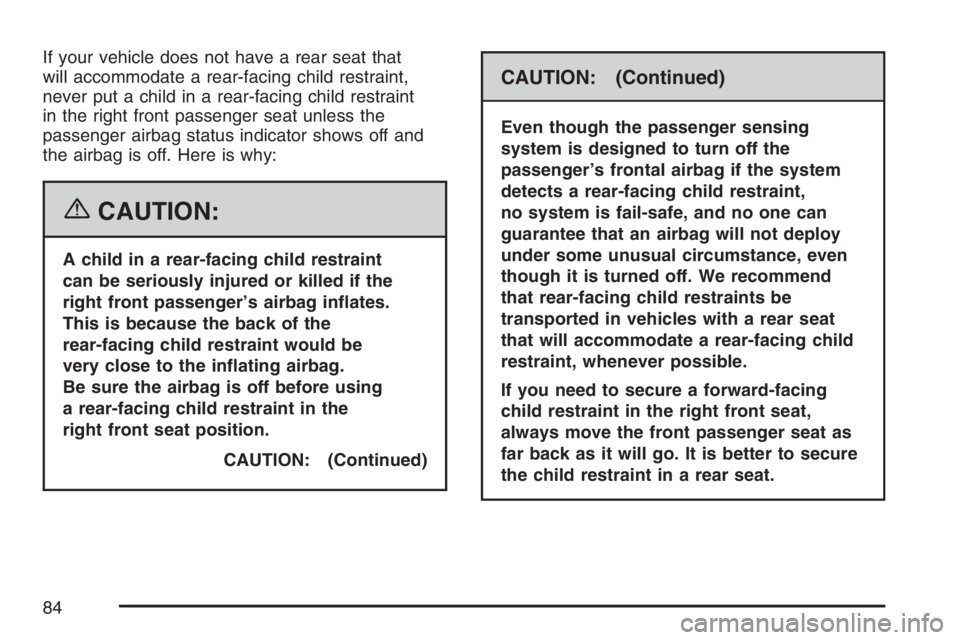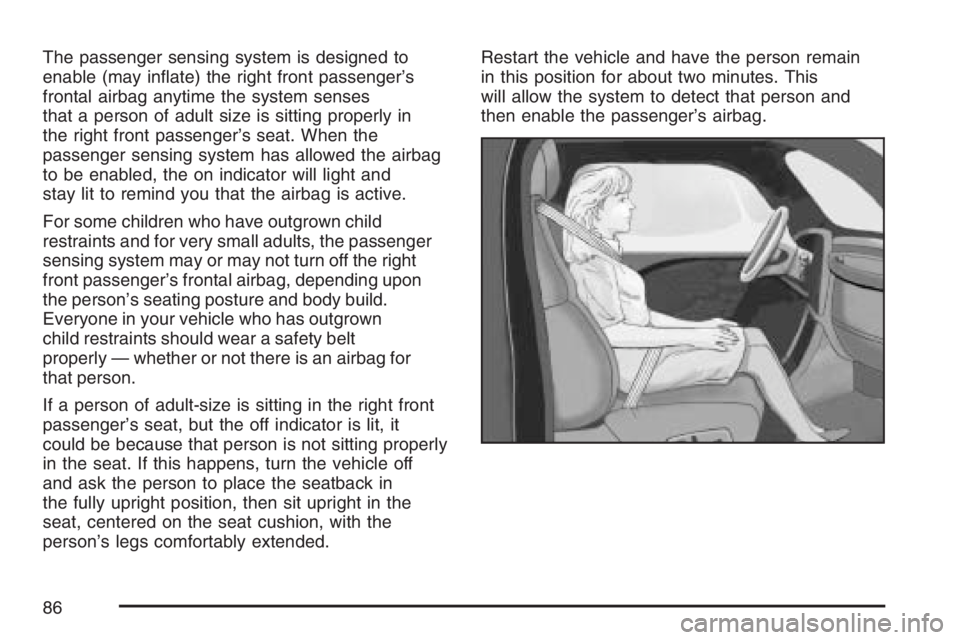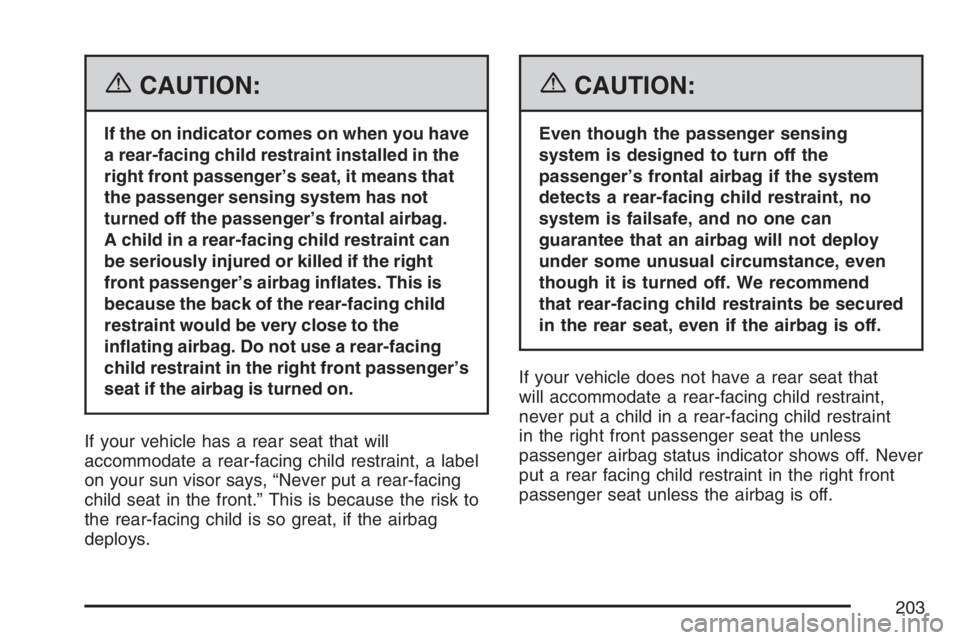2007 GMC ENVOY child seat
[x] Cancel search: child seatPage 68 of 562

If your child restraint has the LATCH system, see
Lower Anchors and Tethers for Children (LATCH)
on page 56.
There is no top tether anchor at the right front
seating position. Do not secure a child seat in this
position if a national or local law requires that
the top tether be anchored or if the instructions
that come with the child restraint say that the top
tether must be anchored. SeeLower Anchors
and Tethers for Children (LATCH) on page 56
if the child restraint has a top tether.
You will be using the lap-shoulder belt to secure
the child restraint in this position. Be sure to follow
the instructions that came with the child restraint.
Secure the child in the child restraint when and
as the instructions say.
1. Your vehicle has a right front passenger’s
frontal airbag. SeePassenger Sensing
System on page 82. We recommend that
rear-facing child restraints be secured in
a rear seat, even if the airbag is off.If your child restraint is forward-facing, move
the seat as far back as it will go before
securing the child restraint in this seat. See
Manual Seats on page 8orPower Seats
on page 9.
When the passenger sensing system has
turned off the right front passenger’s frontal
airbag, the off indicator in the passenger airbag
status indicator should light and stay lit
when you turn the ignition to RUN or START.
SeePassenger Airbag Status Indicator
on page 202.
2. Put the child restraint on the seat.
3. Pick up the latch plate, and run the lap and
shoulder portions of the vehicle’s safety belt
through or around the restraint. The child
restraint instructions will show you how.
68
Page 71 of 562

If, after reinstalling the child restraint and restarting
the vehicle, the on indicator is still lit, check to
make sure that the vehicle’s seatback is not
pressing the child restraint into the seat cushion.
If this happens, slightly recline the vehicle’s
seatback and adjust the seat cushion if possible.
Also make sure the child restraint is not trapped
under the vehicle head restraint. If this happens,
adjust the head restraint.
If the on indicator is still lit, secure the child in
the child restraint in a rear seat position in
the vehicle and check with your dealer.
To remove the child restraint, just unbuckle the
vehicle’s safety belt and let it go back all the
way. The safety belt will move freely again
and be ready to work for an adult or larger
child passenger.Airbag System
Your vehicle has a frontal airbag for the driver
and a frontal airbag for the right front passenger.
Your vehicle may also have roof-mounted side
impact airbags designed for either side impact or
rollover deployment. Roof-mounted side impact
airbags are available for the driver and the
passenger seated directly behind the driver and
for the right front passenger and the passenger
seated directly behind that passenger.
If your vehicle has roof-mounted side impact
airbags, the word AIRBAG will appear on
the airbag covering on the sidewall trim near
the driver’s and right front passenger’s window.
71
Page 82 of 562

Passenger Sensing System
Your vehicle has a passenger sensing system for
the right front passenger’s position. A passenger
airbag status indicator in the rearview mirror will
be visible when you turn your ignition key to
START or RUN.The words ON and OFF, or the symbol for on
and off, will be visible during the system check.
When the system check is complete, either
the word ON or the word OFF, or the symbol for
on or the symbol for off, will be visible. See
Passenger Airbag Status Indicator on page 202.
The passenger sensing system will turn off
the right front passenger’s frontal airbag under
certain conditions. The driver’s airbags are not
part of the passenger sensing system.
The passenger sensing system works with
sensors that are part of the right front passenger’s
seat and safety belt. The sensors are designed
to detect the presence of a properly-seated
occupant and determine if the passenger’s frontal
airbag should be enabled (may in�ate) or not.
Accident statistics show that children are safer
if they are restrained in the rear rather than
the front seat. We recommend that child restraints
be secured in a rear seat, including an infant
riding in a rear-facing infant seat, a child riding
in a forward-facing child seat, and an older
child riding in a booster seat.
United States
Canada
82
Page 83 of 562

If your vehicle has a rear seat that will
accommodate a rear-facing child restraint, a label
on your sun visor says, “Never put a rear-facing
child seat in the front.” This is because the risk
to the rear-facing child is so great, if the
airbag deploys.
{CAUTION:
A child in a rear-facing child restraint can
be seriously injured or killed if the right
front passenger’s airbag in�ates. This is
because the back of the rear-facing child
restraint would be very close to the
in�ating airbag.
Even though the passenger sensing
system is designed to turn off the
passenger’s frontal airbag if the system
detects a rear-facing child restraint,
CAUTION: (Continued)
CAUTION: (Continued)
no system is fail-safe, and no one can
guarantee that an airbag will not deploy
under some unusual circumstance, even
though it is turned off. We recommend
that rear-facing child restraints be secured
in the rear seat, even if the airbag is off.
If you need to secure a forward-facing
child restraint in the right front seat,
always move the front passenger seat as
far back as it will go. It is better to secure
the child restraint in a rear seat.
83
Page 84 of 562

If your vehicle does not have a rear seat that
will accommodate a rear-facing child restraint,
never put a child in a rear-facing child restraint
in the right front passenger seat unless the
passenger airbag status indicator shows off and
the airbag is off. Here is why:
{CAUTION:
A child in a rear-facing child restraint
can be seriously injured or killed if the
right front passenger’s airbag in�ates.
This is because the back of the
rear-facing child restraint would be
very close to the in�ating airbag.
Be sure the airbag is off before using
a rear-facing child restraint in the
right front seat position.
CAUTION: (Continued)
CAUTION: (Continued)
Even though the passenger sensing
system is designed to turn off the
passenger’s frontal airbag if the system
detects a rear-facing child restraint,
no system is fail-safe, and no one can
guarantee that an airbag will not deploy
under some unusual circumstance, even
though it is turned off. We recommend
that rear-facing child restraints be
transported in vehicles with a rear seat
that will accommodate a rear-facing child
restraint, whenever possible.
If you need to secure a forward-facing
child restraint in the right front seat,
always move the front passenger seat as
far back as it will go. It is better to secure
the child restraint in a rear seat.
84
Page 85 of 562

The passenger sensing system is designed to turn
off the right front passenger’s frontal airbag if:
The right front passenger seat is unoccupied.
The system determines that an infant is
present in a rear-facing infant seat.
The system determines that a small child is
present in a forward-facing child restraint.
The system determines that a small child is
present in a booster seat.
A right front passenger takes his/her weight off
of the seat for a period of time.
The right front passenger seat is occupied by
a smaller person, such as a child who has
outgrown child restraints.
Or, if there is a critical problem with the airbag
system or the passenger sensing system.
When the passenger sensing system has turned
off the passenger’s frontal airbag, the off indicator
in the rearview mirror will light and stay lit to
remind you that the airbag is off.If a child restraint has been installed and the on
indicator is lit, turn the vehicle off. Remove
the child restraint from the vehicle and reinstall
the child restraint following the child restraint
manufacturer’s directions and refer toSecuring a
Child Restraint in the Right Front Seat Position
on page 66.
If, after reinstalling the child restraint and restarting
the vehicle, the on indicator is still lit, check to
make sure that the vehicle’s seatback is not
pressing the child restraint into the seat cushion.
If this happens, slightly recline the vehicle’s
seatback and adjust the seat cushion if possible.
Also make sure the child restraint is not trapped
under the vehicle head restraint. If this happens,
adjust the head restraint.
If the on indicator is still lit, secure the child
in the child restraint in a rear seat position in
the vehicle and check with your dealer.
85
Page 86 of 562

The passenger sensing system is designed to
enable (may in�ate) the right front passenger’s
frontal airbag anytime the system senses
that a person of adult size is sitting properly in
the right front passenger’s seat. When the
passenger sensing system has allowed the airbag
to be enabled, the on indicator will light and
stay lit to remind you that the airbag is active.
For some children who have outgrown child
restraints and for very small adults, the passenger
sensing system may or may not turn off the right
front passenger’s frontal airbag, depending upon
the person’s seating posture and body build.
Everyone in your vehicle who has outgrown
child restraints should wear a safety belt
properly — whether or not there is an airbag for
that person.
If a person of adult-size is sitting in the right front
passenger’s seat, but the off indicator is lit, it
could be because that person is not sitting properly
in the seat. If this happens, turn the vehicle off
and ask the person to place the seatback in
the fully upright position, then sit upright in the
seat, centered on the seat cushion, with the
person’s legs comfortably extended.Restart the vehicle and have the person remain
in this position for about two minutes. This
will allow the system to detect that person and
then enable the passenger’s airbag.
86
Page 203 of 562

{CAUTION:
If the on indicator comes on when you have
a rear-facing child restraint installed in the
right front passenger’s seat, it means that
the passenger sensing system has not
turned off the passenger’s frontal airbag.
A child in a rear-facing child restraint can
be seriously injured or killed if the right
front passenger’s airbag in�ates. This is
because the back of the rear-facing child
restraint would be very close to the
in�ating airbag. Do not use a rear-facing
child restraint in the right front passenger’s
seat if the airbag is turned on.
If your vehicle has a rear seat that will
accommodate a rear-facing child restraint, a label
on your sun visor says, “Never put a rear-facing
child seat in the front.” This is because the risk to
the rear-facing child is so great, if the airbag
deploys.
{CAUTION:
Even though the passenger sensing
system is designed to turn off the
passenger’s frontal airbag if the system
detects a rear-facing child restraint, no
system is failsafe, and no one can
guarantee that an airbag will not deploy
under some unusual circumstance, even
though it is turned off. We recommend
that rear-facing child restraints be secured
in the rear seat, even if the airbag is off.
If your vehicle does not have a rear seat that
will accommodate a rear-facing child restraint,
never put a child in a rear-facing child restraint
in the right front passenger seat the unless
passenger airbag status indicator shows off. Never
put a rear facing child restraint in the right front
passenger seat unless the airbag is off.
203